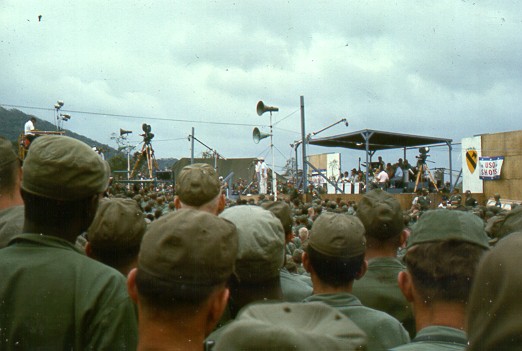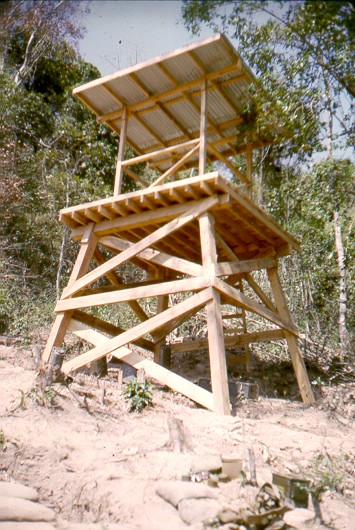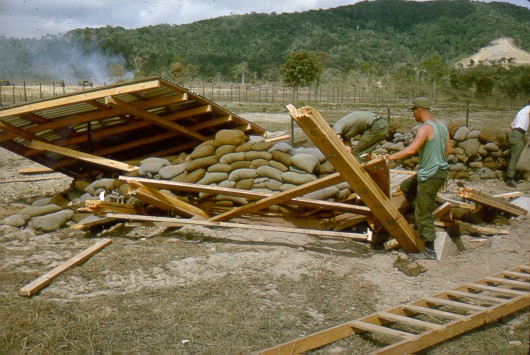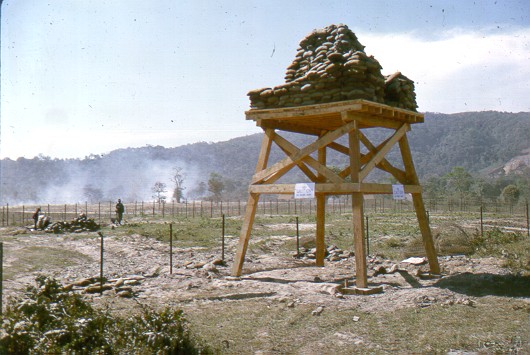
Hugh Savage's Memories
Page 3 of 5
Mail call provided an important connection to “The
World”. At first delivery was unreliable and usually delayed. One officer I knew took it
personally and accused the mail clerk of holding out on him. Then he blamed his wife
for not writing and concluded she was having an affair. Eventually, the situation got so
bad he had to go home on emergency leave to patch up his relationship with his wife.
Next to letters, “Care Packages” were most looked forward to. If food was included, it
had to be shared and eaten quickly before the rats got to it. With the ready availability of
food and the lack of snakes the rat population exploded. It was a creepy feeling to know
if you dangled your hands over the edge of the bed in your sleep, a rat might bite your
fingers.

Bob Hope USO Show at Camp Radcliffe, Dec 1965
The feeling that we were in another world was especially poignant at Christmas. This
was my first Christmas away from home and I could not have been any further away. No
chance of a White Christmas either. But speaking of “White Christmas” makes me think
of Bing Crosby which makes me think of Bob Hope who brought a little bit of The World
to us with his show. Whatever else he may have done, he has my vote for sainthood.
And then the New Year was greeted with a burst of gun, mortar and artillery fire while I
wondered if I wouldn’t be just a teeny bit safer under my cot.
There was an Episcopal Chaplain in the Division and I went to his chapel one Sunday
near Christmas. I mostly reflected on how different this chapel was from our little chapel
at the Student Center at Dartmouth. The tent walls did not amplify our singing as the
brick walls had. Yet I often think back to that time when I am in church today.
v) Platoon Leader
In October or November Captain Fontes was promoted to Major and began commuting
during the week to a job in Saigon. On weekends he would return and pick up his duties
as HQ Co Commanding Officer. I was growing increasingly frustrated by my duties as
acting CO of HQ Co and bored with the lack of activity. I requested either to be given
command of HQ Co or be sent to a line company. I had very much enjoyed my role as
Platoon Leader earlier at Fort Campbell, so I was not disappointed when around the first
of the year I was transferred to a platoon in A Company of the 70th Engineer Battalion.
1LT Mudarra resumed command of HQ Co, the position he had held before CPT Fontes
assumed command prior to our departure from the USA.
The previous Platoon Leader was the one sent home on emergency leave to rescue his
marriage and was a bit paranoid about military courtesy. He saw disrespect where none
was intended. Naturally, his attitude only generated disrespect from the more irreverent
enlisted men. Because of my experience as a leader in Boy Scouts I could be more
relaxed about such things without worrying that it might compromise my authority.
When the change of command was announced to the Platoon they actually cheered.
Within days of my transfer I was promoted to First Lieutenant on January 12th, 1966, left
for a week of R&R (Rest and Relaxation) in Hong Kong and began counting the days I
had left in my tour; 180 days and a wake-up. I was getting short.
When I returned from R&R my platoon was working on maintaining the Division’s
perimeter road. As we were cleaning out a culvert that had filled with silt the backhoe
came up with a tangle of wire. It did not take long to learn that it was the Division’s
main communication cable. Opps!

Soon we had more constructive work to do;
building guard towers for the perimeter
defense. I divided the tasks up among the three
squads. One squad would prepare the site.
Another would precut the parts in the company
area and load the parts on a 5 ton truck or a
helicopter for delivery to the site. The third
squad would erect the towers. Because the
sites were often on hillsides the site preparation
squad would survey the site, I would compute
the geometry and give the measurements to the
precut squad. Our self imposed goal was to
complete one tower each day
With some ingenuity we accomplished our
goal. One example in particular stands out in
my mind. We had to dig holes for the concrete
bases for the tower legs. If the wooden legs
were in contact with the soil the termites would
destroy them within weeks. Laterite, when dry,
is nearly as hard as concrete. Digging the holes
was tedious pick and shovel work and was
slowing us up. SSG Hamilton, 2nd Squad Leader and a wily old timer who knew his way
around the Army and its regulations, suggested that it would be easier to dig the holes if
we used some dynamite to loosen the laterite first. At first I was skeptical that we could
even obtain dynamite but promised to look into to it. I should have known. We had no
problem obtaining all the dynamite we wanted. Production speeded up and morale
improved significantly.

Not all of our sites could be reached by truck. We built several guard towers on the top
of Hong Kong Mountain to protect the Division’s communication center. We loaded all
the precut parts on a Chinook helicopter which flew us and our equipment to the top of
the mountain. Part of our gear included a home made concrete mixer. One of the more
tedious jobs had been mixing the water into the concrete
mix in a large metal basin. We welded a cutoff 55 gallon
drum to a helicopter transmission, connected a gas motor to
the transmission shaft, stuck some wheels on the contraption
and we had a concrete mixer.
I enjoyed meeting such challenges but I still had some free
time. On the afternoon of February 20th, when I had
checked with all the squads and was satisfied that things
were under control I was tempted to hike to the top of Hong
Kong Mountain and check out our guard towers. It was
only about half a mile away and a few hundred feet up. But
there were no trails and the perimeter fence had not been
closed yet. The woods might contain unfriendlies.
Prudence won over my sense of adventure. Or perhaps it
was Providence for that very night the communications
center at the top of the mountain was attacked and heavily
damaged by mortar and small arms fire. As I watched the
flames and listened to the firing from relative safety of a
bunker on Engineer’s Hill I shook as I realized that had I climbed the mountain that
afternoon I might have encountered the guerrillas and may not have lived to tell this
story.
After we had completed about 7 or 8 towers I was checking the newest site we were
preparing when I got an urgent call on the radio informing me that one of our towers had
collapsed. I jumped in the jeep and my trusty driver SP4 Browning got me there as fast
as possible. It was not a pretty sight. The guard tower consisted of a raised platform
about 12 feet off the ground with a metal shed roof over it. The infantry stacked sand
bags around the edge of the platform and on the shed roof to protect them from small
arms fire and mortar shrapnel. The troops reported that as they loaded the platform it
began to shake alarmingly. They had gotten off it just before it crashed to the ground.
I was sure I was in hot water. I reported what I had found


to the Battalion S-3, MAJ
Robinson, who was very gracious about the situation. He told me that boards bolted
together had been used for the legs because the 8”x8” timbers that were specified were
not available. The bolt holes had weakened the timbers and indeed when I returned to the
collapsed tower I noticed that the legs had snapped at the bolt holes. Suddenly the
specified timbers became available and we had to tear down all the towers made with the
bolted lumber and rebuild them. The first one we rebuilt we loaded with twice the
expected load of sandbags just to be sure. It held fine and we had no more collapsing
towers.


To Go
Forward or Back Click on Arrows






